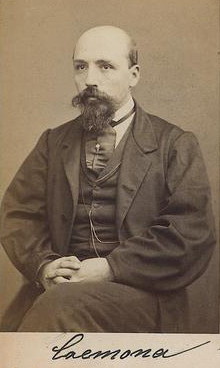Luigi Cremona
Antonio Luigi Gaudenzio Giuseppe Cremona (born December 7, 1830 in Pavia , Lombardy , † June 10, 1903 in Rome ) was an Italian mathematician , structural engineer and most recently a politician .
Life
Cremona grew up studying in Pavia. In the uprisings of 1848/1849 he participated as a non-commissioned officer in the defense of Venice against the Austrians. Because of their bravery, they were given free retreat and Cremona continued his engineering studies in Pavia. He also studied mathematics with Francesco Brioschi and Felice Casorati . He received his doctorate in 1852, but was initially unable to find a teaching position due to his revolutionary past and gave private lessons with various families, but also published scientific papers on the side. In 1857 he became a high school teacher in Cremona and in 1859 in Milan . In 1860, by royal decree, shortly before the unification of Italy, he became professor in Bologna and from 1866 in Milan at the Polytechnic Institute. From 1873 he was at the university in Rome and head of the engineering school there.
In 1879 he went into politics and became a senator . After he became Minister of Education, he gave up scientific work.
In 1902 he was elected to the American Academy of Arts and Sciences . From 1879 he was a foreign member of the Royal Society and from 1883 honorary member ( Honorary Fellow ) of the Royal Society of Edinburgh . In 1898 he became a corresponding member of the Académie des Sciences in Paris. He was a member of the Bavarian and Prussian Academy of Sciences and the Academy of Sciences in Göttingen . In 1964 a moon crater was named after him. He died of a heart attack.
Act
Cremona developed the Cremonaplan (Cremona force plan), a drawing method to determine the bar forces of statically determined frameworks . He built on the work of James Clerk Maxwell . The Cremona diagram is still in the structural analysis a simple method of frame analysis and the truss theory. His work also includes geometric works on algebraic curves and surfaces . Here the Cremona transformations are named after him. He examined them in several papers from 1863-1865, for which he received the Steiner Prize in 1866. Cremona was an excellent teacher and was one of the founders of the Italian geometric school. One of his students was Giuseppe Veronese .
Fonts (selection)
- Corso di statica grafica . (1867)
- Elements of projective geometry , 1882, Elementi di geometria proiettiva . (1873)
- Elementi di calcolo grafico . (1874)
- Graphical statics. Two treatises on the graphical calculus and reciprocal figures in graphical statics . Translated by Thomas Hudson Beare (1890)
- Opere matematiche , 3 vols. 1914
literature
- U. Bottazzini-Lauro Rossi: Cremona, Luigi. In: Alberto M. Ghisalberti (Ed.): Dizionario Biografico degli Italiani (DBI). Volume 30: Cosattini – Crispolto. Istituto della Enciclopedia Italiana, Rome 1984.
- Max Noether : Luigi Cremona , Mathematische Annalen 59, 1904, pp. 1–19 (obituary)
- Rudolf Sturm : Luigi Cremona , Archive of Mathematics and Physics 8, 1905, pp. 11–29 and 195–213 (obituary; in the Internet archive, with gaps: [1] )
- Karl-Eugen Kurrer : The History of the Theory of Structures. Searching for Equilibrium . Ernst & Sohn , Berlin 2018, pp. 437, 455ff., 937 u. 984 (biography), ISBN 978-3-433-03229-9 .
Individual evidence
- ^ Fellows Directory. Biographical Index: Former RSE Fellows 1783–2002. Royal Society of Edinburgh, accessed October 18, 2019 .
- ^ List of members since 1666: Letter C. Académie des sciences, accessed on November 3, 2019 (French).
- ^ Member entry of Luigi Cremona (with a link to an obituary) at the Bavarian Academy of Sciences , accessed on January 20, 2017.
- ^ Members of the previous academies. Luigi Antonio Gaudentio Josephe Cremona. Berlin-Brandenburg Academy of Sciences and Humanities , accessed on January 20, 2017 .
- ↑ Cremona (moon crater) in the Gazetteer of Planetary Nomenclature of the IAU (WGPSN) / USGS
Web links
- Entry in the Senatori dell'Italia liberale database of the Historical Archives of the Italian Senate
- John J. O'Connor, Edmund F. Robertson : Luigi Cremona. In: MacTutor History of Mathematics archive .
- His collected works, books on statics and projective geometry are online here: [2]
| personal data | |
|---|---|
| SURNAME | Cremona, Luigi |
| ALTERNATIVE NAMES | Cremona, Antonio Luigi; Cremona, Antonio Luigi Gaudenzio Giuseppe |
| BRIEF DESCRIPTION | Italian mathematician, structural engineer (Cremonaplan) and politician |
| DATE OF BIRTH | December 7, 1830 |
| PLACE OF BIRTH | Pavia (Lombardy) |
| DATE OF DEATH | June 10, 1903 |
| Place of death | Rome |
